
2001- 2002
I started using the cyber link during the
summer 2001. When people asked me where I had been for my
holidays, I got strange looks when I said cyberspace!
I have been working with Dr. P Coia and Patricia
Hall at Fieldhead Hospital. We have been researching a brainwave
device called the cyberlink. We are the first in the UK
to research the cyberlink. The Cyberlink device is an interface
to communicate between humans and machines. The Cyberlink
Interface enables hands-free control of computers and electrical
devices. Pretty good if you haven’t got any controls
over your hands. The Cyberlink system is easy and fun to
use especially games and can be learned fairly quickly depending
on the particular person. It has three sensors on a headband
and an interface box. The three Sensors in the headband
detect your brain and facial activity (i.e. Jaw and eyebrows
etc..). The Cyberlink interface unit amplifies and translates
this data into separate frequencies and transmits them to
the computer. The Cyberlink software processes and displays
these frequencies as 10 continuous command signals called
Brain fingers and up to 4 discrete command signals generated
by specific eye and facial gestures.
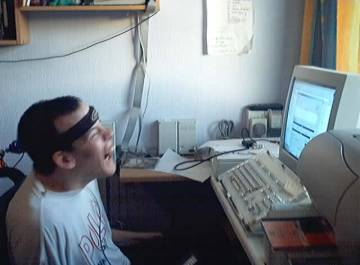 Strap
on the headband, plug into your computer and let your mind
do the rest. The brain and body signals detected by the
sensors in the headband are amplified, digitised and transmitted
to the computer as multiple Brain fingers to affect feedback
displays, control a mouse or an interactive video game,
navigate a productivity or business application, use a web
browser, control almost any Windows application, play musical
synthesizers or sound cards, activate peripheral devices,
adjust environmental controls, etc.
Strap
on the headband, plug into your computer and let your mind
do the rest. The brain and body signals detected by the
sensors in the headband are amplified, digitised and transmitted
to the computer as multiple Brain fingers to affect feedback
displays, control a mouse or an interactive video game,
navigate a productivity or business application, use a web
browser, control almost any Windows application, play musical
synthesizers or sound cards, activate peripheral devices,
adjust environmental controls, etc.
Cyberlink Interface is based on a breakthrough
technology that senses and responds to the minute surface
electrical signals that result from brain and subtle muscle
activity. Twelve different biological signals derived from
the forehead control the location and left/right functions
of the mouse. Individual control formats and adjustments
are easily made through the user-friendly graphical interface.
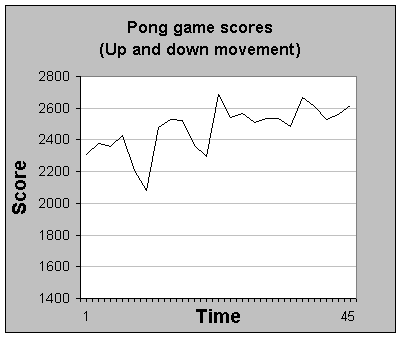
In the first week I worked on the eyebrow
settings on the pong (bat & ball) game for up and down
movements.
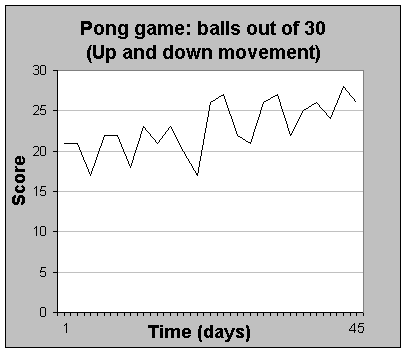
After the 5th day on the cyber link I decided
to used a brain wave on the pong for the left & right
movements. After many hours of experimenting on each brain
wave, I found the F6 mode to be the best for controlling
the left and right movements of the bat. The F6 is an alpha
wave. I discovered that if I think of something exciting
the bat will move to the right and relaxing or being sad
will make the bat go to the left. After many hours of practicing
it does become easier to control and now I sometimes find
this is easier than the eyebrow click. But it does depend
on how I’m feeling. At first the F6 control was very
tiring, but now not so much.
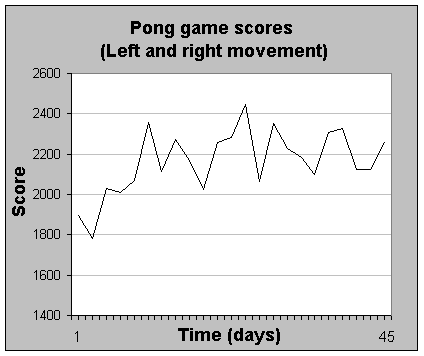
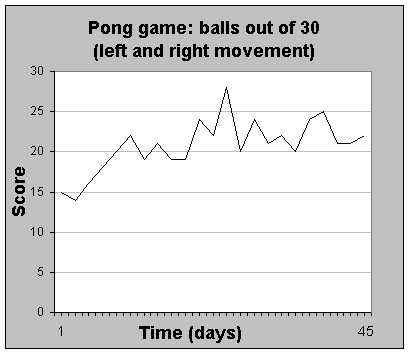
I have been practicing on a Labyrinth game.
I have been using the F6 brainwave mode to control the left
& right movements and the eyebrow click to move up and
down. The easy-labyrinth is very straightforward to accomplish.
The harder level of labyrinth I can achieve but it takes
a lot of concentration.
My fastest time on -:
Easy labyrinth is 14 seconds
Hard labyrinth is 64 seconds
The cyberlink also has a typing program. I
use the eyebrow click to select letters. During the first
week it took me over 5 minutes to type Patricia. My fastest
time is 35 seconds and the average is 88 seconds. My typing
ability is variable. It depends on how I am feeling.
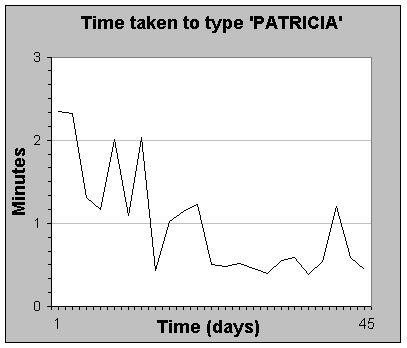
For me to type Patricia on my light-talker
it takes 20 seconds, but using my head pointer on a normal
keyboard is still the fastest method. That takes 9 seconds.
The Brain Billiards is a good program for learning how to
control your brainwaves and relaxing.
The blue balls are controlled by the low frequency
brain waves in order to move the balls up and down.
The red balls respond to the the high frequency
brain waves. To move them, I have to try to create a feeling
of mental intensity. The red balls will also repond to subtle
forehead muscle contractions.
The green Balls are responsive to the mid-frequencies.
The up and down movements are controlled by defocusing my
gaze or not attending to the task in a concentrated way.
Basically this game is all about relaxing
your mind to let the balls go down, and to get the balls
to up you have to concentrate.
The asteroids game is basically good way of
practicing with the mouse. I use the eyebrow click to fire
the laser weapon to break-up oncoming asteroids. The right
and left control responds to the F6 brain wave. On level
two, the up and down control is added to provide a 4 way
motion of the weapon crosshairs. I move the crosshairs up
and down by subtle forehead muscle contractions.
Side effects
I had a few side effects when I went on the
cyber link longer than an hour.
After an hour I would get really tired. After
2 hours, I felt tired tired and got head aches. Once I got
carried away and spent 3 hours on it. This made me feel
dizzy, like my head was spinning.
I think I suffered from these side effects
as I was trying too hard. Consequently my brain was overloading
as it wasn’t used to so much activity from the subtle
facial muscle and eye movements in addition to altering
my brainwaves in this kind of tense, concentrated way.
After 3 weeks on the cyber link, I decided
to limit myself to 45 minutes to an hour each day. I haven’t
been getting any more head aches but I have felt a little
bit tired sometimes, especially when using the F6 brain
wave mode.
Noticed
I have noticed if I type first before playing
pong, I make a lot of errors and I am very slow at typing
‘Patricia’ However, after playing pong I am much
more better at typing.
After playing the asteroids and Tetris for
many hours, I thought I would practice with the mouse. After
endless hours of practicing and adjusting the settings I
have a little bit control over it. Meaning, when I went
right or up, the mouse goes diagonally to the right hand
corner, and the same with the left or down movements to
the left hand corner. I found this very frustrating to achieve
up, down, left and right separately. As I spent hours on
this I wasn’t seeing any really improvements. As I
really wanted to use the mouse with it. I think I will require
a lot of practice to achieve this task.
Overall
My thoughts of cyber link – As soon as
I went on it I knew the cyber link was something special.
All my life I’ve been using switches basically there
have been the same, ok maybe a little changes to them over
the years. The cyber link is different from an ordinary
switch, as ordinary switches takes about 30 minutes to set-up
in the right position so the particular user can press the
switch by their hands, feet, head etc… The cyber link
takes weeks or months to calibrate the settings properly
depending on the user, I was using it for 8 weeks, and I
even didn’t calibrated the settings fully on myself.
In the first week I was working on the eyebrows settings
on the pong game for up & down movements. It was really
strange using my eyebrows as I never used my eyebrows before
in this way. When I obtained improvements with the eyebrows
consequently the eyebrows settings needed to be adjusting
again. I have noticed it is sometimes really hard to move
the bat down on the pong game this is when my forehead muscles
are really tense. To overcome this I will have to take a
rest for a minute. This usually occurs when I have been
on it over 45mins. A lot of users get Repetitive Strain
Injuries on ordinary switches; however, I don’t think
they will get it on the cyberlink as the user is only moving
their eyebrows. The cyber link is definitely a break through
as it is the next generation of switches. I think cyberlink
will be very useful for people with Cerebral Palsy, like
myself, however, I also think this will be a powerful tool
for users who have bone diseases like latest stages of muscular
dystrophy to improve their quality of life. There is some
work from the states on a small number of people with various
types of head trauma (e.g. someone who was diagnosed as
in a persistent vegetive state - who managed to type hello!
Before cyberlink they thought the person couldn’t communicate
with anyone.